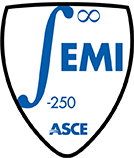Study on Rubberized Concrete Reinforced with Different Fibers
Michigan Technological University
Problems
The sustainable material and structure lab's primary professional and scholarly contributions have dealt with material design, characterization, test and analysis for sustainable civil infrastructure applications, especially on self-healing, self-regulation, damage mechanism diagnosis and multi-physical interactions in asphalt mixtures, concrete or geopolymer. The sustainable material-related research incorporated municipal solid waste such as scrap tire rubber or glass into concrete for improved durability and bio-processed waste Kraft lignin as adhesives or coating materials. The structure resilience-related research has been conducted on smart actuator design, test and simulation for structural vibration reduction and power distribution structure resilience simulation under multi hazard loading conditions.
Approach
The research has been involved with other multidisciplinary areas: multiphysics, computational simulation, molecular dynamic simulation, image-based computation, advanced material characterization methods, nondestructive testing, damage detection and mechanism, smart polymer chemistry, alternative and sustainable infrastructure materials, active-material based actuator design, aerodynamic and aeroelastic simulation, and structural resilience for cross-laminate timber building, energy storage and power distribution system.
Findings
Developed the advanced characterization methods and simulation model for damage in concrete and asphalt mixtures. Develop new sustainable materials with recycled components.
Impact
This research developed durable concrete and benefit the industries involved with concrete design and construction in cold regions. The durability of concrete plays a central role in the sustainability of the whole infrastructure system on which such regions depend for their development. In this project, research and educational activities will be integrated to promote teaching, training, and learning for the K-12 students and teachers, undergraduate and graduate students in engineering and science, and professional engineers. Additionally, the methodology developed in this project for understanding the frost damage mechanisms of concrete will be applicable for solving other durability issues such as salt scaling and chemical reaction.
Core competencies
- Computational analysis for material research: multiscale modeling, finite element analysis, discrete element analysis, multiphysical modeling, fracture simulation and molecular dynamics.
- Advanced material characterization: micro or nano x-ray CT, SEM, (U)SANS, SAXS, PDF.
- Self-healing asphalt mixtures, self-regulation concrete with pH sensitive hydrogels.
- Internal curing concrete, early-age properties and concrete durability.
- Nlternative and sustainable infrastructure materials with recycled produces including scrap tire rubber and glass, and bio-waste materials such as lignin.
- Nondestructive testing methods and damage detection and mechanisms.


